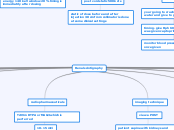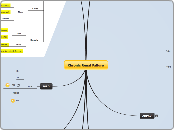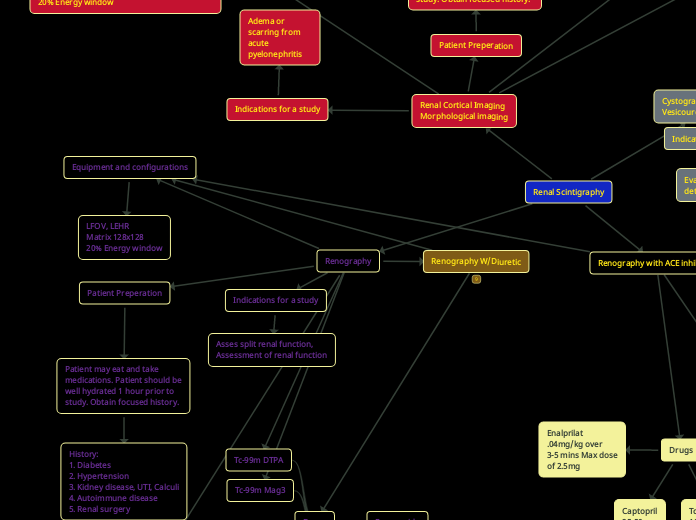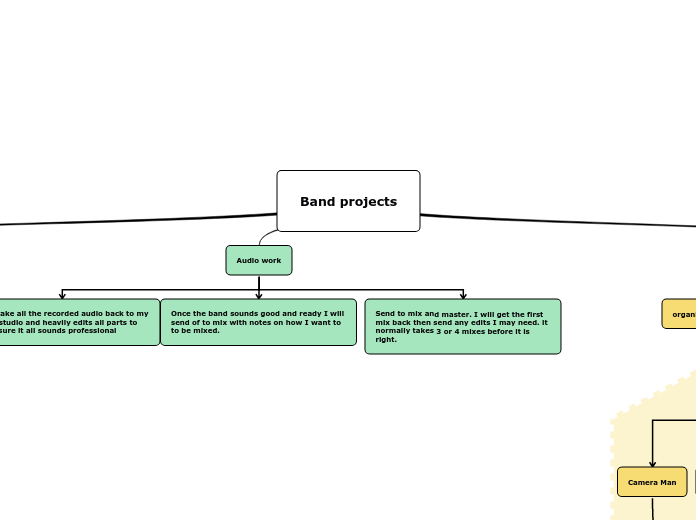injection into a foley catheter by injection port
cystography
bladder
Activity in upper urinary tracts during filling, full capcity, and while voiding
No reflux visualized
All or almost all of solution is voided from the bladder
interpertation
total bladder volume of residual post void volume and bladder volume at initiation of reflux can be measured
residual volume- (voided volume)(post void ct)/prevoid ct -post void ct
total volume - voided volume+ residual volume
reflux volume-ROI cts x totalbladder vol/prevoid bladder ROI ct
initial volume- total volume - total saline instilled
bladder volume at reflux- initial volume + saline reflux volume
procedure
45 min
hang 250-500 mL saline bag (make sure tubing is clamped) for gravity feed infusion (no higher than 100 cm above table) note amount of saline at start and finish volume going to need tone instilled
(age+2)x30
filling phase
start camera for flow, fill bladder completely with Rph/ saline mixture. monitor P-scope closely for signs of reflux. if reflux is seen, record amount of saline infused at that time. when bladder is full, stop flow images and take 120 sec immediate static of POST and Lt and Rt POST obliques. record amount of saline used to fill bladder and cpm during POST view instruct pt to resist the urge to urinate.
voiding phase
start flow study. deflate folley balloon have pt void take a 120 sec immediate post void POST static and record CPM. measure and determine volume in mL voided by pt
review images for any reflux
sitting up and pelvis against camera bladder and bag FOV some kidneys
Tc99m SC
agitate before injecting-particles can settle to the bottom or on the sides of the syringe
Tc99m DTPA
0.5-1 mCi
kit prep
shake and shoot
LFOV gamma camera LEAP or LEHR collimator 64x64
filling phase 10 sec/frame for 1 min 64x64
pre void phase 120 sec static image
voiding 2 sec/frame for 120 sec
post void phase 120 sec static image
pregnancy/breastfeeding
before you bring patient back cover all equipment with chucks
keep additional chucks on hand
ID patient
verify DO
explain procedure
consent for catherzation
void prior to starting scan
use a clean weighed diaper for infant
note amount of saline start to finish
indications/symptoms
Evaluation and detection of vesicoureteral reflux - VUR
diahrea
lack of appittie
fever
strong family history
direct - scan using a catheter, is preferred it has a higher sensitivity and specificity than the indirect method
indirect- scan without using scan
morphological renal imaging
critical organ
kidney/bladder wall
abnormal
pyelonephritis is reconized by the decrease of uptake
uptake in a column of bertin but not in a mass caused by a tumor
normal
homogeneous uptake in both kidneys
should demonstrate a smooth renal contour
shape of kidneys vary, as is the thickness of the cortex
upper poles may often appear less intense due to splenic impression on the cortex and attenuation from liver and spleen
Tc99m GH
adult 10-20 mCi children 200 uCi/kg
MOL-secreted by glomerular filtration and tubular secretion
kit needs to be refrigerated
renal clearance is 50% at 3 hours
Tc99m DMSA *perferred
adult 5 mCi children 50uCi/kg
websters rule for pediatric dose; (age+1)/(age+7)x adult dose
MOL- tubluar binding , it is taken up by the renal cortex (proximal convoluted tubule)
90% is bound to plasma protein after injection
approximatly 16% of DMSA will be in urine 3 hours after injection
data acqusition
timing- 2 hours after dosing
statics - 500K cts each image for a total of 5 images.
views- POST/RAO/LAO/RPO/LPO with kidneys in the center of FOV
SPECT- 180 degrees- 40 views per head 3 degrees/stop or 40 sec/stop
LFOV gamma camera
parallel hole collimator for differential calculation
pinhole collimator for for cortical images
SPECT single, dual, or triple head
pregnancy or breast feeding
dehydrated
well hydrated two 8 oz. of water
IV
informed consent- for children sedation my be ideal
detection of pyelonephritis
used to detect the presence or absence of small renal infarctions
Adema or scarring from acute pyelonephritis
hypertrophied columns of Bertin are not uncommon and can mimic a renal mass lesion, thus it is important to detect it because it alleviates biopsy and radical surgery.
confirmation of suspected hypertrophied column or Bertin
renal wit6h ACE inhibition renogram
optional manuver
some protocols use IV furosemide shortly afterRph to clear the renal collecting systems of activty, which can interfere with cortical indices.
adults- 0.3-0.5 mg/kg
Subtopic
decrease in renal uptake
high blood pressure-hypertension is renin dependent.
prolongation of renal parenchymal transit
normal blood pressure
systolic- 90-140mmHg
diastolic 60-90mmHg
final blood pressure reading should be obtained at end of study
ACE inhibitors
Enalaprilat
orthostatic hypertension
0.04 mg/kg in 10 mL saline, IV over 5 min
timing- 10 min wait time after injection
Captopril
adverse effects
orthostatic hypertesion
rash
chest pain
tachycardia
loss of taste
25-50 mg pill
your going to crush pill, then put in water and give to patient.
timing- give Rph 60 min after patient was given captopril
monitor blood pressure every 15 min once given
flow- 2 sec/frame for 1 min 128x 128
contraindcation
patient dehydrated
not NPO 4-6 hours prior
patient not off ACE inhibitors/diuretics/A2 blockers 4 days prior
pregnant or breastfeeding
not NPO 48 hrs captopril
not NPO 1 week for lisinopril or enalaprilat
hydrate 1 hour prior 10 mL/kg
NPO 4-6 hours prior
4 days prior stop diuretics/ACE inhibitors/ A2 blockers
obatin a baseline blood pressure and start IV
NPO 48 hrs for captoptil
NPO 1 week for lisinopril or enalaprilat
indication
SNM procedure guidlines
renovascular hypertension
abrupt onset or severe hypertension
abdominal or flank bruits
unexplained azotemia in elderly hypertensive patient
recurrent pulmonary edema in an elderly hypertensive patient
hypertension in infants with an umbilical artery catheter
importance of this study
sensitive non-invasive
used for diagnosing renalvascular hypertension 1-4% of all cases of hypertension.
blocks A1 to A2
diuretic renal scintigraphy
organ receiving largest dose of radiation
diuretic
calculate the ERPF
you should start to see the diuretic take in effect within first min
1/2 T clearnace should be by 10 min
the diuretic will be part of the graph
1/2 T clearance longer then 20 mins
urodynamically significant outflow obstruction is present
asymmetrical excretion
1/2T clearnce of less then 10 min
rapid and almost complete washout of radio tracer
both kidneys should excrete symmetrically
radiopharmaceutical
diuretic lasix(furosemide)
storing
room temp
keep out of light
drug interactions
furosemide may increase the ototoxic potential of aminoglycoside antibiotics
in pateints with anuria
patients with anhistory of hypersensitivity to furosemide
adveres effects
nausea
vomiting
diarrhea
headache
dizziness
hypotension
adult 0.3-0.5 mg/kg given over 2 to 3 min or based on creatinine levels children 1 mg/kg with max 40 mg
timing
F+0
F+20
F-15
Tc99m DTPA or MAG3
adults 10-15 mCi. children 100 uCi/kg max 5 mCi
iv bolus
LFOV gamma camera LEAP or LEHR collimator
flow 20 sec/frame for 1 to 2 min 128x128
dynamic 20-30 sec/frame for 20 min 256x 256
post void static 500k
energy 140 keV window 20%
contraindcations
recent NM study
pregancy or breast feeding
dehydration, diuretics
well hydrated-IV hydration is more relaible in the diagnosis of questionable cases of urinary obstruction
catheter for children/infants-in some cases the diagnosis of obstruction may be more reliable with bladder catheter
obtain serum creatinine levels
void prior
review patients hostory of urinary tract obstruction, prior surgery to the urinary tract and congenital abnormaities are important for accurate interpretaton of the study.
withhold diuretics for 24 hrs prior
indications
evaluation of dilated renal collecting system vs. obstructed renal collecting system
prenatal ultrasound diagnosis of hydronephrosis
post-surgical evaluation of a previously obstructed system.
distension of pelvicalyceal system as an etiology of back pain.
Renal scintigraphy
artifacts
phantom kidney-spleen overlies the left kidney giving a false impression of asymmetrically increased renal perfusion in patients with prior left nephrectomy
horseshoe kidney- a congenital abnormality where the bottom of the kidneys are connected.
attenuation
patient movement
foreshortening-planar artifact where kidney appears smaller then actual size
organ recieving largest dose of radiation
bladder wall
optional maneuvers
renal transplant
renal with ACE inhibitors- captopril oral 25-50mg should be taken hour prior to study or enalaprilat 0.04mg/kg IV should be given 10-15 prior study.
renal with lasix
processing
"a rengoram is simply a time activity curve that provides a graphic representation of the uptake and excretion of the Rph by the kidneys".
3 phases
3. clearance or excretion phase- represents the down slope of the curve and is produced by excretion of the Rph from the kidney and clearance from collecting system.
2. tubular concentration phase- first 1-5 mins and contains the peak of the curve. The inital uptake slope closely correlates with the ERPF vaules.
1. vascular transit phase- first 30-60 sec and represents blood flow of the Rph in each kidney. Should be symmetric . It should exceed or be equal that of the aorta .
ROIs are drawn over the aorta- may be used to asses the discreteness and adequacy of the injected bolus as well as relative renal perfusion.
ROIs are drawn around the kidneys - renogram curves are generated by these ROIs. occasionally just draw around the renal cortex if a considerable amount of collecting system is oresent.
background subtractions ROIs- are selected just inferior to each kidney.
ROIs around bladder
abnormal study
anything 40% or below
difference between kidneys 20% or more
delay in transit of Rph in kidneys
asymmetrical
normal study
renal uptake @ 2-3 min
1/2 T excretion 8-12 min
activity 50% by 20 min
max activity by 3-5 min
symmetrical
imaging technique
views- POST
patient supine with kidneys and bladder in FOV
transplant patients
they should be supine with ANT view images
radiopharmaceuticals
Tc99m DTPA or MAG3 which is perferred
10-15 mCi
IV bolus
MOL DTPA glomarular filtration MOL MAG3 tubluar secretion
kit prep for MAG3-vent with a needle to remove some nitrogen, add 20-100 mCi in 2 mL to vial, heat NOT boil for 10 min, cool for 15 min. Remove some pressure from vial then add 3 more mL for a total of 5cc. the tag needs to be 90% or better for it to be usable.
when looking for ERPF we use MAG3 normal ERPF is 600 ml/min
kit prep for DTPA- is very simply shake and shoot is all you need to do.
when looking for GFR we use DTPA normal GFR rate is 120ml/min
data acquisition and analysis
flow- 2 sec/frame for total 30 frames 128x 128
dynamic- 20 sec/frame for total 20 min 256x256
post void static 500k cts
static of dose before and after injection 30 cm from collimator is done at some clinical settings
energy 140 keV window 20% timing is immediatrly after dosing
detector system
LFOV Gamma Camera. LEAP collimator, for pediatrics diverging collimator may be optimal.
contraindications
dehydration
recent nuclear medicine study.
pregnant or breastfeeding.
patient prep
Encourage patient to void prior to scan and after
if not an abnormal renogram curve demonstrating delayed peak activity, delayed Rph clearance or an elevation of the ecretion slope can result.
patient should be well hydrated 1 hour before study 2 to 3 8 oz. cups of water over 30 min.
Indications
evaluation of renal perfusion and function and collecting system patency information.
relative renal function- both kidneys should function relatively the same.
renal transplant evaluation- is for checking that the transplant is not leaking urine,renal infarction, rejection obstruction, or cyclosporine toxicity.
acute renal failure-- helps determine their prognosis and most helpful in excluding acute vascular obstruction as a cause of renal failure.
obstructive uropathy-evauate obstruction in ureters
renovascular hypertension- evaluate renin hormone which is located in the kidneys that effects high blood pressure.
infection or inflammation-can be caused by bacteria. UTI is most common infection can escalate to a kidney infection. 85% is causative organsim is eschrichia coli
vesicoureteral reflux-evaluates the possibility of back flow of urine up the ureters.









